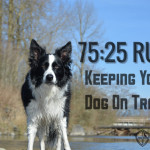Herding Behavior – How to Control the Out of Control
If you have any herding breeds, you will most likely experience the one or more times where your dog sees something moving (kids playing, dogs playing, animals running, skateboards, etc.) and goes absolutely bonkers with ears perked up, tunnel vision on and that neck stretched out towards the target(s). This is your dogs’ predatory instincts kicking in, which is vital for any good herder to use because this predatory behaviour is used to intimidate the prey (cattle, sheep, geese, etc.) to move.
What to Do About It
You cannot train an instinct out of a dog and you cannot stop it. Hopefully when you got your herding breed or mix that you understood what you were getting into and have accepted it as part of your dog. But what do you do about the behaviour that can get out of control and cause problems? We put control to the out of control through the Premack Principle.
What Is The Premack Principle?
This is where more probable behaviours will reinforce less probable behaviours. More probable behaviour in a herder’s case is chasing “the prey” and less probable behaviours are “listening to handler/not chasing prey”. If you’ve ever been to herding lessons, you will see the instructor working with a dog by allowing the dog to do what they want to do (safely) and then that instructor will ask for a quick behaviour that the dog doesn’t want to do, such as stop moving for a moment, or if it’s a more mature dog, lie down for a moment. As soon as that instructor gets the less probable behaviour (stopping/lying down) they will allow your dog to do what he or she wants again which is to chase the prey.
The instructor will repeat this over and over, keeping the reward (chasing prey) at a high rate of reinforcement (meaning 75-90% of the time they get to do what they want), so the dog is encouraged to quickly perform the less probable behaviour (lie down/stop) in hopes to get back to doing the more probable behaviour (chase prey).
How to Incorporate Premack Principle into Day-to-day Training
There are three “musts” you should follow in order to achieve the most success:
1) Management. Don’t allow your dog to practice the undesirable behaviour on his whim, like whenever he feels like chasing a squirrel, they just take off. The dog will learn that he has no use for you; he can get what he wants by following his impulses. This can involve strict on leash activities (lead and long line) until the dog starts learning that he’s not able to do what he wants to do. This is where we come in.
2) Pro-active training. For you to have control over your dog’s prey drive, you need to make sure the dog knows these 3 easy behaviours:
- “focus” or “look at me” cue – asking to go chase
- “stay” or “wait” or “down/drop” cue – stopping the dog when needed
- “off” or “that’ll do” – calling the dog off/stop working
Once your dog knows these three cues in training sessions, start using them in everyday life.
3) Controlled sessions. These are set up sessions where the thing your dog wants most is “managed” so there are no “oopsie moments”. Let’s say we’re working with a dog that is obsessed about chasing any animal that moves. We go to a secure field where we will see bunnies, your dog on a sturdy long line and the other side attached to you. Walk around until you spot a bunny, once the bunny has been spotted by your dog, he will want to run after it or stalk it; we are going to encourage stop and ask, then stalk.
Dog spots bunny. Stand beside your dog. Ask your dog to sit or down. Ask your dog to “focus” (look at you).
- If the dog complies – mark it with a “good” and ask the dog to “walk-up”, taking his leash and slowly moving him towards the bunny (his reward).
- If the dog doesn’t comply (too hard), stand in front of your dog so he can no longer see the bunny, DO NOT MOVE until that dog gives you eye contact (negative punishment, we’re taking away what he wants if he doesn’t listen).
- Once he gets annoyed enough and looks up at you, mark the behaviour with a “good” and ask the dog to “walk up”, taking his leash and slowly moving him towards the bunny) his reward).
- After a few steps, ask your dog to “lie down”, repeat the last step.
- Once the bunny is “gone”, get your dog to do one last “down & focus”
- When you get a “down and focus”, release your dog to go “chase and find”, allowing your dog to run after where the bunny went, encourage the dog to “find, find!”
- After a good while of the dog running, call him or her off with a “that’ll do” (which means, you’re all done, no more). At this time you need to allow the dog to understand that he or she will not get the bunny and to do something else, like walk out of the park.
The key about turning a herding breed OFF, is if you don’t they will constantly “work” and this isn’t healthy for any dog. Once you notice the dog stops “work mode” and is normal again, you can opt to go back and play again, then Premack Principle again (turn off to turn back on again).
The more you work on the behaviour, the better your dog will respond. It takes time to override an instinct and put control to it, but it can be easily done if you follow the rules!
Article By:
Kris Crestejo, CDBC
Meet Our Evangelist, Kris Crestejo, CDBC.







